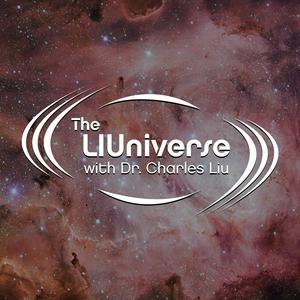Cosmic Raspberries and Life on Mars with Dr. Kelly Blumenthal
Have we discovered life on Mars? What does the center of our galaxy taste like? To find out, and to kick off Season 5 of The LIUniverse, Dr. Charles Liu and co-host Allen Liu have reached out all the way to Tokyo to chat with Dr. Kelly Blumenthal, the Director of the International Astronomical Union Office for Astronomy Outreach.
As always, though, we start off with the day’s joyfully cool cosmic thing, a rock found in Sapphire Canyon by the Mars Perseverance Rover containing potential biosignatures. Allen explains why this rock is different: iron and sulfur nodules that exhibit indications of layers which, on Earth, could only be formed by bacteria. Kelly points out that there needs to be more investigation before we can say anything for sure.
Chuck asks Kelly, who when she was 12 told her dad that she wanted to study galaxy evolution, to describe the research she did at the start of her career. She talks about studying with pioneering astronomer Joshua Barnes in Hawaii during her Masters projects and PhD. For her first project, she studied star formation rates in Jellyfish Galaxies, which are being ram-stripped of their gases and so appear to have tendrils. She ended up looking at the history of merging galaxies through cosmic time using large cosmological simulations.
Then it’s time for our first student question of Season 5, from Jeannie, who asks, “Now that we’ve found so many planets outside of our solar system, should Pluto be promoted as a planet again?” (Pluto’s “demotion” nearly 20 years ago was traumatic for some.) According to Kelly, though, the “demotion” was really a reclassification, and at least for the time being, Pluto is going to stay a dwarf planet, a new category of which it was the first of its kind. She contrasts Pluto to the moons of Jupiter and reminds us of the new rules about what’s a planet and what’s not.
Kelly brings up Star Trek and therefore gives Chuck permission to geek out over “Devil in the Dark” from the Star Trek: The Original Series, and “Silicon Avatar” from Star Trek: The Next Generation. Kelly talks about bingeing sci-fi in high school including 2001: A Space Odyssey, and the Foundation series, and more recently, The Expanse series, which she’s listened to three times as audio books!
Chuck and Kelly discuss communicating about science, and even the role science fiction can play. Kelly talks about the importance of understanding your audience. She uses the example of explaining what nebulas look like through the Chandra X-Ray Observatory to a blind and low-vision audience. Kelly also talks about how you can approach science through poetry, music, dance, theatre and art – even smell. She recalls a talk where someone working with incarcerated kids, who was limited in what props they could bring, made the universe come alive for them using the scent of raspberries, which have a similar chemical signature as the center of our galaxy.
For our next audience question, Bridget asks, “So is that comet actually an interstellar spaceship?” Kelly debunks the notion that Comet 3I/ATLAS is anything other than a rock that’s come from outside our solar system and explains why extrasolar asteroids are amazing things.
We end with a discussion of the IAU’s upcoming, worldwide “100 Hours of Astronomy” on Oct. 2-5, 2025, including a 24-hour live stream on Oct. 4 from the oldest functioning planetarium in Japan. Watch it live on YouTube via the IAU Office for Astronomy Outreach @IAUoutreach here.
You can also visit their website at https://iauoutreach.org/, follow IAU Office for Astronomy Outreach on Facebook and LinkedIn, and on Instagram @oao_iau. If you have any questions, email them at
[email protected].
You can follow Kelly on LinkedIn.
We hope you enjoy the Season 5 premiere of The LIUniverse. Please support us on Patreon.
Credits for Images Used in this Episode:
Observatory History Museum at NAOJ in Mitaka – Credit: おむこさん志望, CC BY 3.0
“Sapphire Canyon” sample – Credit: NASA Perseverance Rover
Iron Bacteria in Scotland – Credit: Roger Griffith
Jellyfish Galaxy ESO 137-001 – Credit: NASA/ESA/CXC
Jellyfish Galaxy JO201 – Credit: ESA/Hubble & NASA, M. Gullieuszik, CC BY 4.0
New Horizons probe before launch – Credit: NASA
Pluto’s “Heart”, Tombaugh Regio – Credit: NASA / Johns Hopkins University Applied Physics Laboratory / Southwest Research Institute
Chandra X-ray Observatory (Illustration) – Credit: NASA/CXC/NGST
Interstellar Comet 3I/Atlas – Credit: International Gemini Observatory/NOIRLab/NSF/AURA/Shadow the Scientist, CC BY 4.0
Artist’s illustration of interstellar asteroid 1I/'Oumuamua – Credit: NASA, ESA, Joseph Olmsted (STScI), Frank Summers (STScI)
Interstellar Comet 2I/Borisov – Credit: NASA, ESA, and D. Jewitt (UCLA)
100 hours of Astronomy! – Credit: IAU, CC BY 4.0
#liuniverse #sciencepodcast #astronomypodcast #kellyblumenthal #lifeonmars #bacteria #jellyfishgalaxy #pluto #interstellarasteroid #comet3iatlas #iau #officeforastronomyoutreach #startrek #theoriginalseries #thenextgeneration #theexpanse


